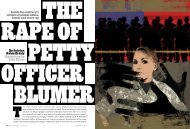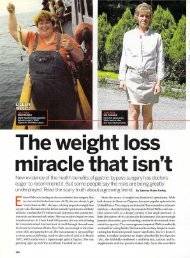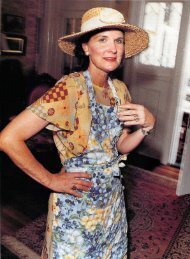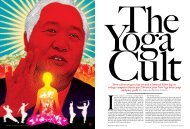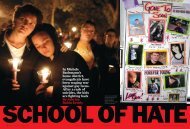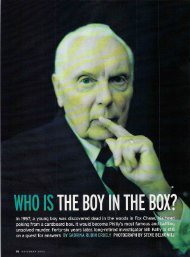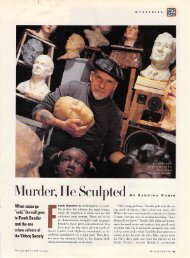The Catholic Church's Secret Sex-Crime Files - Sabrina Rubin Erdely
The Catholic Church's Secret Sex-Crime Files - Sabrina Rubin Erdely
The Catholic Church's Secret Sex-Crime Files - Sabrina Rubin Erdely
Create successful ePaper yourself
Turn your PDF publications into a flip-book with our unique Google optimized e-Paper software.
THE CATHOLIC CHURCH’S<br />
HOUSE OF SIN<br />
This page: <strong>The</strong><br />
archdiocese of<br />
Philadelphia’s<br />
office tower,<br />
where church<br />
officials hid the<br />
<strong>Secret</strong> Archives<br />
files. Opposite:<br />
<strong>The</strong> basilica of<br />
St. Peter and Paul,<br />
the seat of the<br />
church in the city.<br />
00 | Rolling Stone | rollingstone.com Month xx, 2010
SECRET SEX-CRIME FILES<br />
How a scandal in<br />
Philadelphia exposed the<br />
church’s most-guarded<br />
archive – documents that<br />
reveal a high-level<br />
conspiracy to cover up<br />
decades of sexual abuse<br />
by <strong>Catholic</strong> priests<br />
By SABRINA RUBIN ERDELY<br />
Photographs by SACHA LECCA<br />
Month xx, 2010<br />
rollingstone.com | Rolling Stone | 00
CHURCH SEX CRIMES<br />
<strong>The</strong> five co-defendants sit close enough to<br />
shake hands in the Philadelphia courtroom, but they never<br />
once acknowledge one another. Father James Brennan,<br />
a 47-year-old priest accused of raping a 14-year-old boy,<br />
looks sad and stooped in a navy sweater, unshaven and<br />
sniffling. Edward Avery, a defrocked priest in his sixties,<br />
wears an unsettlingly pleasant expression on his face, as<br />
though he’s mentally very far away. He and two other defendants – the<br />
Rev. Charles Engelhardt, also in his sixties, and Bernard Shero, a former<br />
<strong>Catholic</strong> schoolteacher in his forties – are accused of passing around<br />
“Billy,” a fifth-grade altar boy. According to the charges, the three men<br />
raped and sodomized the 10-year-old, sometimes making him perform<br />
stripteases or getting him drunk on sacramental wine after Mass.<br />
Heinous as the accusations are, the<br />
most shocking – and significant – are<br />
those against the fifth defendant, Monsignor<br />
William Lynn. At 60, Lynn is portly<br />
and dignified, his thin lips pressed together<br />
and his double chin held high. In a dramatic<br />
fashion statement, he alone has chosen<br />
to wear his black clerical garb today, a<br />
startling reminder that this is a priest on<br />
trial, a revered representative of the <strong>Catholic</strong><br />
Church, not to mention a high-ranking<br />
official in Philadelphia’s archdiocese.<br />
Lynn, who reported directly to the cardinal,<br />
was the trusted custodian of a trove<br />
of documents known in the church as<br />
the “<strong>Secret</strong> Archives files.” <strong>The</strong> files prove<br />
what many have long suspected: that officials<br />
in the upper echelons of the church<br />
not only tolerated the widespread sexual<br />
abuse of children by priests but conspired<br />
to hide the crimes and silence the victims.<br />
Lynn is accused of having been the archdiocese’s<br />
sex-abuse fixer, the man who covered<br />
up for its priests. Incredibly, after a<br />
scandal that has rocked the church for a<br />
generation, he is the first <strong>Catholic</strong> official<br />
ever criminally charged for the cover-up.<br />
“All rise,” the court crier intones as the<br />
judge enters, and Lynn stands, flanked<br />
by his high-powered lawyers, whose hefty<br />
fees are being paid by the archdiocese. <strong>The</strong><br />
implications of the trial are staggering for<br />
the church as a whole. In sheltering abusive<br />
priests, Lynn wasn’t some lone wolf<br />
with monstrous sexual appetites, as the<br />
church has taken to portraying priests who<br />
have molested children. According to two<br />
scathing grand-jury reports, protocols for<br />
protecting rapists in the clergy have been<br />
in place in Philadelphia for half a century,<br />
under the regimes of three different<br />
cardinals. Lynn was simply a company<br />
man, a faithful bureaucrat who did his job<br />
exceedingly well. His actions were encouraged<br />
by his superiors, who in turn received<br />
orders from their superiors – an unbroken<br />
<strong>Sabrina</strong> <strong>Rubin</strong> <strong>Erdely</strong> wrote “<strong>The</strong><br />
Girl Who Played With Fire” in RS 1129.<br />
64 | Rolling Stone | rollingstone.com<br />
“IF YOU PULL THE<br />
STRING ON THIS ONE,”<br />
SAYS A PSYCHOLOGIST<br />
WHO SPECIALIZES<br />
IN TREATING THE<br />
CLERGY, “IT WILL<br />
UNRAVEL ALL THE<br />
WAY TO ROME.”<br />
chain of command stretching all the way<br />
to Rome. In bringing conspiracy charges<br />
against Lynn, the Philadelphia district attorney<br />
is making a bold statement: that the<br />
<strong>Catholic</strong> hierarchy’s failure to protect children<br />
from sexual abuse isn’t the fault of<br />
an inept medieval bureaucracy, but rather<br />
the deliberate and criminal work of a cold<br />
and calculating organization. In a very real<br />
sense, it’s not just Lynn who is on trial here.<br />
It’s the <strong>Catholic</strong> Church itself.<br />
<strong>The</strong> deluge of sexual-abuse cases in<br />
America’s largest religious denomination<br />
began in 1985, when a Louisiana priest<br />
was sentenced to 20 years in prison after<br />
admitting to sexually abusing 37 boys.<br />
But it wasn’t until 2002, when civil suits<br />
in Boston revealed that Cardinal Bernard<br />
Law had shielded rapist priests, that<br />
the extent of the scandal became widely<br />
known. In Germany, the church is overwhelmed<br />
by hundreds of alleged victims,<br />
and investigations are under way in Austria<br />
and the Netherlands. In Ireland, the<br />
government recently issued a scathing<br />
report that documents how Irish clergy<br />
– with tacit approval from the Vatican –<br />
covered up the sexual abuse of children as<br />
recently as 2009.<br />
Battered by civil suits and bad press,<br />
the church has responded with a headspinning<br />
mix of contrition and deflection,<br />
blaming anti-<strong>Catholic</strong> bias and the<br />
church’s enemies for paying undue attention<br />
to the crisis. <strong>The</strong> U.S. Conference of<br />
<strong>Catholic</strong> Bishops helped fund a $1.8 million<br />
study of sex-abuse cases against<br />
priests, but the results read like a mirthless<br />
joke: To lower the number of clergy<br />
classified as “pedophiles,” the report redefines<br />
“puberty” as beginning at age 10 –<br />
and then partially blames the rise in child<br />
molesting on the counterculture of the<br />
1960s. <strong>The</strong> church also insists that any sex<br />
crimes by priests are a thing of the past.<br />
“<strong>The</strong> abuse crisis,” the study’s lead author<br />
concluded, “is over.”<br />
That echoed statements by Archbishop<br />
Timothy Dolan of New York, who went on<br />
60 Minutes declaring the scandal “nothing<br />
less than hideous” and then, with a sweep<br />
of his hand, announced, “That’s over with!”<br />
Dolan, in turn, sounded a lot like Bishop<br />
Wilton Gregory, the former president of the<br />
USCCB, who framed the lie more eloquently:<br />
“<strong>The</strong> terrible history recorded here is<br />
history.” That was in 2004, seven years ago.<br />
Given how the innermost workings of<br />
<strong>Catholic</strong> culture have long been cloaked<br />
in secrecy, the case in Philadelphia offers<br />
a rare opportunity to understand why the<br />
cover-up of sexual abuse has continued<br />
for so long, despite the church’s repeated<br />
promises of reform. <strong>The</strong> answer, in large<br />
part, lies in the mindset of the church’s<br />
rigid hierarchy, which promotes officials<br />
who are willing to do virtually anything<br />
they’re told, so long as it’s in God’s name.<br />
“It’s almost like the type of stuff you see<br />
in cult behavior,” says a former Philadelphia<br />
priest who asked not to be identified<br />
for fear of retribution. “Someone on the<br />
outside would say, ‘That’s crazy.’ But when<br />
you’re on the inside, you say, ‘It’s perfectly<br />
right, because everything is divinely<br />
inspired.’ If you have a monopoly on God,<br />
you can get away with anything.”<br />
Long before he became the<br />
guardian of the church’s secrets,<br />
Bill Lynn was a boy with a higher<br />
calling. In the fall of 1968,<br />
after graduating from Bishop<br />
McDevitt High School in the<br />
suburbs of Philadelphia, Lynn<br />
arrived at St. Charles Borromeo Seminary,<br />
a stately campus whose soaring chapels,<br />
somber libraries and marble sculptures<br />
with heads bowed in prayer gave<br />
off an aura of reverence, history and costly<br />
precision. Lynn, a friendly, overweight<br />
boy whose acne-scarred face was topped<br />
with jet-black hair, was ready to begin his<br />
eight-year path to priestly ordination, a<br />
process the church calls “formation.”<br />
At St. Charles, Lynn was plunged into<br />
an environment in which every moment<br />
was accounted for. Strict rules governed<br />
all aspects of life, especially the personal.<br />
September 15, 2011
Besides the obvious prohibitions on sexual<br />
contact – including with oneself, or<br />
even in one’s imagination – no seminarian<br />
was allowed to get too close with his peers,<br />
since he was to concentrate on developing<br />
bonds with God and the church. Seminary<br />
is a form of military-style indoctrination,<br />
molding men to think institutionally,<br />
not individually. “It’s like a brainwashing,<br />
almost,” says Michael Lynch, who attended<br />
St. Charles for nine years but was rejected<br />
for priesthood after repeatedly butting<br />
heads with his superiors. Lynch recalls a<br />
priest barking at his class, “We own you!<br />
We own your body, we own your soul!”<br />
<strong>The</strong> goal of priesthood is a lofty one: a<br />
man placed on a pedestal for his community<br />
to revere, an alter Christus – “another<br />
Christ” – who can literally channel the<br />
power of Jesus and help create the perfect<br />
society intended by God. To model that<br />
“<strong>The</strong> <strong>Catholic</strong> Priest in the United States:<br />
Psychological Investigations” found that<br />
three-fourths of all American priests were<br />
psychologically and emotionally underdeveloped,<br />
or even “maldeveloped.” <strong>The</strong> attitudes<br />
of these grown men toward sex, the<br />
study concluded, were on par with those of<br />
teenagers or even preteens.<br />
Lynn thrived in seminary, where he<br />
made an impression as an affable guy who<br />
always toed the line. At his ordination, he<br />
took a solemn oath of obedience to the<br />
bishop, sealing himself into the church’s<br />
vertical framework, in which everyone is<br />
bound to the strata above them. He was<br />
assigned first to a parish in Philadelphia,<br />
then to a wealthy church in the suburbs.<br />
His parishioners liked him, and Lynn’s<br />
deference to his senior pastor made an<br />
impression on the archdiocese. In 1984,<br />
when a job as dean of men opened up at St.<br />
required the utmost loyalty and discretion.<br />
Lynn now reported directly to Cardinal<br />
Anthony Bevilacqua. If a priest broke<br />
the rules or stepped out of line in any way,<br />
it would be Lynn’s job to discipline him and<br />
inform his superiors. That, says the former<br />
priest familiar with St. Charles, is precisely<br />
why Lynn was chosen for the job: “<strong>The</strong>y<br />
sure as hell weren’t going to pick someone<br />
who was going to send priests to jail.”<br />
Every catholic diocese has<br />
<strong>Secret</strong> Archives files – it’s mandated<br />
by canon law as a repository<br />
for complaints against priests<br />
so scandalous that they must be<br />
kept out of the regular personnel<br />
files. Few outsiders know the secret<br />
archives exist, and only the most trusted<br />
clergy have access to them. In Philadelphia,<br />
the sole keyholders were the cardinal<br />
1 2 3 4 5<br />
PHILADELPHIA DISTRICT ATTORNEY’S OFFICE/AP IMAGES, 5<br />
perfection and elevate themselves above<br />
the sinful laity, clergy adopt a vow of celibacy,<br />
which has served as a centerpiece<br />
of <strong>Catholic</strong> priesthood since the 12th century.<br />
It’s a tall order to sculpt chaste, living<br />
incarnations of Jesus out of the sloppy<br />
clay of your average 18-year-old male.<br />
Even many of those who wind up being<br />
ordained fail to maintain their chastity:<br />
According to a 1990 study by psychologist<br />
Richard Sipe, only half of all priests adhere<br />
to their vows of celibacy. It is not just<br />
the sex-abuse epidemic the church seeks to<br />
deny, but sex itself.<br />
“<strong>The</strong> real secret here is the sexual life<br />
of cardinals and bishops,” says Sipe, a former<br />
Benedictine monk who specializes in<br />
treating clergy and who has followed the<br />
case against Lynn. “If you pull the string<br />
in a knitted sweater, you’ll unravel the<br />
whole thing. This will unravel all the way<br />
to Rome.”<br />
Many seminarians dropped out of St.<br />
Charles; others, informed that they weren’t<br />
priestly material, were “invited” to leave.<br />
Those who remained were the ones willing<br />
to surrender to the process of formation:<br />
men prepared to bend to the will of their<br />
higher powers, both earthly and divine.<br />
Such intensive focus on preparing for one’s<br />
“priestly burdens,” however, often meant<br />
that men emerged from the incubator of<br />
seminary ill-prepared for the complexities<br />
of life itself. In 1972, while Lynn was<br />
still at St. Charles, a landmark study called<br />
<strong>The</strong> Accused<br />
<strong>The</strong> five defendants in the<br />
sex-abuse trial that has shaken<br />
the church to its core: (1) former<br />
priest Edward Avery, (2) Rev.<br />
Charles Engelhardt, (3) Rev.<br />
James Brennan, (4) <strong>Catholic</strong><br />
schoolteacher Bernard Shero and<br />
(5) Monsignor William Lynn.<br />
Charles, Lynn was plucked to fill it. “<strong>The</strong><br />
dean is there to make sure you’re being<br />
formed properly,” explains a former Philadelphia<br />
priest familiar with the appointment.<br />
“A dean is also the type of person<br />
you want your students to want to be. We<br />
wanted to replicate priests in the model<br />
we had already been creating – nice, compliant,<br />
faithful priests. So we put Bill Lynn<br />
there: a nice, compliant, faithful priest we<br />
wanted young men to look up to.”<br />
Over the next eight years, Lynn was a<br />
hands-on adviser. He’d wake seminarians<br />
who overslept for Mass, take them to task<br />
for missing household chores and monitor<br />
their spiritual progress. Lynn proved<br />
himself to his superiors as someone who<br />
didn’t disrupt the status quo, someone<br />
who could be trusted. In 1992, at age 41, he<br />
was named secretary of the clergy, a position<br />
that effectively made him the humanresources<br />
director for the 400 or so priests<br />
in greater Philadelphia. It was a job that<br />
and his closest aides. <strong>The</strong> files were kept<br />
in a row of unlabeled, gray-green cabinets<br />
in a windowless room on the 12th floor of<br />
the archdiocese’s Center City office tower.<br />
Inside was an exhaustive compendium of<br />
scandals dating back more than 50 years:<br />
priests with drinking problems, priests<br />
who had gotten women pregnant, aging<br />
stacks of confiscated pornography. <strong>The</strong>n<br />
there were the reams of carefully typed<br />
memos that discussed priests with what<br />
the archdiocese delicately referred to as<br />
“unnatural involvements” or “unusual patterns.”<br />
Priests, in other words, who had<br />
sexually abused the children in their care.<br />
One memo directed to Cardinal Bevilacqua<br />
in 1989 described a pedophile<br />
priest’s evaluation at an archdioceseowned<br />
hospital, in which the doctor “is<br />
of the very strong opinion that Father<br />
Peter J. Dunne is a very sick man” who<br />
should be removed from ministry; the<br />
memo warned that Dunne’s problem was<br />
so acute “that we are sitting on a powder<br />
keg.” Another file began with a sheaf of letters<br />
that Father Joseph Gausch, an active<br />
pastor, had sent another priest detailing<br />
his sex with an eighth-grade boy in 1948,<br />
three years after his ordination. Gausch<br />
called it “the closest approximation to an<br />
old-fashioned roll that I have had in years<br />
. . . and the subject was oh-so-satisfactory<br />
and (this is what makes the story) willin’.”<br />
In both cases, the response from the cardinal<br />
was the same: secret therapy, then re-<br />
September 15, 2011<br />
rollingstone.com | Rolling Stone | 65
CHURCH SEX CRIMES<br />
assign the offending priest to a new parish<br />
and pretend nothing had happened.<br />
In the thick file devoted to Father Raymond<br />
Leneweaver, who had been moved<br />
to four different parishes after admitting<br />
to molesting at least seven boys, officials<br />
fretted in 1980 that they had run out of<br />
places to send him “where his scandalous<br />
action would not be known.” Scandal<br />
is a word that pops up throughout the <strong>Secret</strong><br />
Archives files. <strong>The</strong> officials writing<br />
the internal memos almost never express<br />
concern for the victims – only concern<br />
over the risk to the church’s reputation.<br />
If the risk was deemed low, an offending<br />
priest was simply reassigned to a different<br />
parish. If the risk was high, priests<br />
were shipped to a far-off diocese with the<br />
permission of the reigning bishop, a practice<br />
known as “bishops helping bishops.”<br />
Even in rare cases where word of a<br />
priest’s crimes leaked out, the cardinal<br />
was reluctant to expose the priest. Leneweaver<br />
was such a case; his ministry<br />
career ended only after he resigned. “His<br />
problem is not occupational or geographical,”<br />
wrote the cardinal at the time, “and<br />
will follow him wherever he goes.” Having<br />
acknowledged the severity of Leneweav-<br />
er’s compulsions, the cardinal released<br />
him from the clergy but still chose<br />
not to inform law-enforcement<br />
officials of his crimes. With his<br />
clean record, Leneweaver, an admitted<br />
child-rapist, went on to take<br />
a job as a teacher at a public middle<br />
school in suburban Philadelphia.<br />
Bill Lynn understood that his<br />
mission, above all, was to preserve<br />
the reputation of the church. <strong>The</strong> spoken rule was clear: Never call the<br />
unpolice.<br />
Not long after his promotion,<br />
Lynn and a colleague held a meeting<br />
with Rev. Michael McCarthy, who<br />
had been accused of sexually abusing<br />
boys, informing the priest of the<br />
fate that Cardinal Bevilacqua had<br />
approved: McCarthy would be reassigned<br />
to a “distant” parish “so that the<br />
profile can be as low as possible and<br />
not attract attention from the plainant.” Lynn dutifully filed his memo of<br />
comthe<br />
meeting in the <strong>Secret</strong> Archives, where<br />
it would sit for the next decade.<br />
Over the 12 years that he held the job<br />
of secretary of the clergy, Lynn mastered<br />
the art of damage control. With his fellow<br />
priests, Lynn was unfailingly sympathetic;<br />
in a meeting with one distraught<br />
pastor who had just admitted to abusing<br />
boys, Lynn comforted the clergyman<br />
by suggesting that his 11-year-old victim<br />
had “seduced” him. With victims, Lynn<br />
was smooth and reassuring, promising<br />
to take their allegations seriously while<br />
doing nothing to punish their abusers.<br />
Kathy Jordan, who told Lynn in 2002 that<br />
she had been assaulted by a priest as a student<br />
at a <strong>Catholic</strong> high school, recalls how<br />
he assured her that the offender would<br />
1<br />
4<br />
no longer be allowed to work as a pastor.<br />
Years later, while reading the priest’s obituary,<br />
Jordan says it became clear to her<br />
that her abuser had, in fact, remained a<br />
priest, serving Mass in Maryland. “I came<br />
to realize that by having this friendly, confiding<br />
way, Lynn had neutralized me,” she<br />
says. “He handled me brilliantly.”<br />
In his very first year on the<br />
job, Lynn received a letter from a<br />
29-year-old medical student that<br />
would trigger the events that led to<br />
his arrest 19 years later. <strong>The</strong> student<br />
– whom the grand jury would call<br />
“James” – reported that as a teenage<br />
altar boy he had been molested by his<br />
priest, Father Edward Avery. <strong>The</strong> popular<br />
and gregarious Avery, nicknamed “<strong>The</strong><br />
Smiling Padre,” was considered hip for<br />
2<br />
THE COVER-UP<br />
(1) Father Avery, who<br />
DJ’d on weekends,<br />
was institutionalized<br />
for sexual abuse.<br />
After he was<br />
released, Cardinal<br />
Bevilacqua (2)<br />
reassigned him to<br />
St. Jerome (3), a<br />
parish where Avery is<br />
accused of raping a<br />
fifth grader. (4) One<br />
of the secret memos.<br />
a priest; he moonlighted as a DJ at weddings<br />
and invited lucky boys for sleepovers<br />
at his house at the Jersey Shore. <strong>The</strong> med<br />
student included a copy of a letter he had<br />
written to Avery. “I have let too much of<br />
my life be controlled by this terrible wrong<br />
you committed,” it read. “You had no right<br />
to hurt me the way you did. You have no<br />
right to hurt anyone else this way.”<br />
This was a code-red situation that Lynn<br />
had to get under control. He began by<br />
interviewing James, who described how<br />
Avery had molested him at the beach<br />
house, at the parish rectory and on a ski<br />
trip to Vermont, sometimes after plying<br />
him with beer. James said he wasn’t looking<br />
for money – only an assurance that<br />
Avery would no longer be a threat to children.<br />
That was surely a relief: the risk<br />
of scandal was clearly low. Next, Lynn<br />
3<br />
CLOCKWISE FROM TOP LEFT: ELWOOD P. SMITH/“PHILADELPHIA DAILY NEWS”; BRAD C. BOWER/AP IMAGES; SACHA LECCA<br />
66 | Rolling Stone | rollingstone.com<br />
September 15, 2011
confronted Avery, whom he’d known in<br />
seminary. According to Lynn’s memo, the<br />
priest admitted that some of the allegations<br />
“could be” true – but insisted it had<br />
been “strictly accidental” and that he had<br />
been so drunk at the time, he couldn’t recall<br />
exactly what had happened.<br />
According to church protocol, an admission<br />
of any kind meant a priest must<br />
be sent for medical care. So Lynn recommended<br />
that Avery seek treatment at<br />
St. John Vianney Hospital, a facility in<br />
the leafy Philadelphia suburb of Downingtown<br />
that maintained a discreet inpatient<br />
program that treats sexually abusive<br />
priests. Cardinal Bevilacqua approved<br />
the request, but the bureaucratic wheels<br />
moved slowly: Avery remained in the pulpit<br />
for another 10 months before he was<br />
hospitalized for his secret therapy. After<br />
his release, his doctors prescribed that he<br />
be monitored by an aftercare team consisting<br />
of Lynn and two other priests. But the<br />
church did not take the recommendation<br />
seriously. <strong>The</strong> team did not meet for more<br />
than a year – one priest later testified that<br />
he didn’t even know he was on the team.<br />
Avery’s doctors also recommended that<br />
he be kept away from teens and other “vulnerable”<br />
populations. Instead, the church<br />
assigned Avery to a new residence with<br />
plenty of exposure to kids: St. Jerome, a<br />
parish in northeast Philadelphia that included<br />
an elementary school. (<strong>The</strong> rectory<br />
had an empty bed because its previous resident,<br />
Rev. Bill Dougherty, had been quietly<br />
moved to another parish after being<br />
accused of abusing a high school girl.) Officially<br />
speaking, Avery didn’t work at the<br />
parish – he simply lived there, with an assignment<br />
as a chaplain at a nearby hospital.<br />
With encouragement from Lynn, he<br />
became a regular presence at St. Jerome,<br />
serving Mass and hearing confessions. He<br />
took on more DJ jobs than ever, booking<br />
gigs almost every weekend. “He seemed<br />
mesmerized, focused, as if he became a different<br />
person DJ’ing,” recalls Rev. Michael<br />
Kerper, who split shifts with Avery at the<br />
hospital. Kerper, under the impression that<br />
Avery had been moved to a low-pressure<br />
chaplain job after a nervous breakdown,<br />
worried that Avery was risking another<br />
collapse by spreading himself so thin. One<br />
day, when Avery failed to show up at the<br />
hospital while on call, Kerper wrote the<br />
archdiocese to express his concern. He addressed<br />
his letter to Monsignor Lynn.<br />
Lynn surprised Kerper by calling him<br />
directly and telling him to mind his own<br />
business. “You’re not going through the<br />
proper channels,” Lynn snapped. “You’re<br />
not his supervisor.” Avery was permitted<br />
to continue working as a DJ and pitching<br />
in at St. Jerome. <strong>The</strong> following year, according<br />
to the grand jury, Lynn received<br />
an e-mail from James, who was looking for<br />
assurance that Avery had been reassigned<br />
to “a situation where he can’t harm others<br />
. . . for my peace of mind, I have to know.”<br />
September 15, 2011<br />
Lynn reassured James that the archdiocese<br />
had taken proper steps. <strong>The</strong>n Lynn<br />
met with Avery and instructed him to be<br />
“more low-keyed.” In doing so, says the<br />
grand jury, Lynn helped set the stage for<br />
the horror that came next.<br />
was a 10-yearold<br />
student at St. Jerome<br />
School in 1998, and an<br />
altar boy just like his older<br />
brother before him. A<br />
sweet, gentle kid with boyish<br />
good looks, Billy was ‘Billy”<br />
outgoing and well-liked. One morning,<br />
after serving Mass, Rev. Charles Engelhardt<br />
caught Billy in the church sacristy<br />
sipping leftover wine. Rather than get<br />
mad, however, the priest poured Billy more<br />
wine. According to the grand jury, he also<br />
“IT WAS LIKE<br />
INFILTRATING A<br />
RACKETEERING<br />
ORGANIZATION,” SAYS<br />
ONE PROSECUTOR.<br />
“THEY WEREN’T LIKE<br />
PRIESTS – THEY WERE<br />
JUST THUGS.”<br />
Billy’s alleged abuse at<br />
the hands of the Philadelphia<br />
priests might have remained<br />
a secret, if not for the church’s<br />
inept attempt at spin control.<br />
After the abuse scandal in Boston<br />
broke open in 2002, every<br />
<strong>Catholic</strong> diocese in America had rushed to<br />
reassure its parishioners. Philadelphia was<br />
no different: Cardinal Bevilacqua declared<br />
that in the previous 50 years, his archdioshowed<br />
him some pornographic magazines,<br />
asking the boy how the pictures<br />
made him feel and whether he preferred<br />
the images of naked men or women. He<br />
told Billy it was time to become a man and<br />
that they would soon begin their “sessions.”<br />
A week later, Billy learned what Engelhardt<br />
meant. After Mass, the priest allegedly<br />
fondled the boy, sucked his penis<br />
and ordered Billy to kneel and fellate him<br />
– calling him “son” while instructing him<br />
to move his head faster or slower – until<br />
Engelhardt ejaculated. <strong>The</strong> priest later<br />
suggested another “session,” but Billy<br />
refused and Engelhardt let him be.<br />
A few months later, while Billy was putting<br />
away the bells following choir practice,<br />
he was taken aside by another priest:<br />
Father Avery. According to the grand jury,<br />
Avery told Billy that he had heard all about<br />
the boy’s “session” with Engelhardt – and<br />
that Avery’s own “sessions” with him would<br />
soon begin. Billy pretended not to know<br />
what Avery was talking about, but his<br />
stomach lurched. Later, after Billy served<br />
a morning Mass with Avery, the priest led<br />
him to the sacristy, turned on some music<br />
and told him to do a striptease. When<br />
Billy dutifully started shedding his clothes,<br />
Avery instructed him to dance to the music<br />
while undressing. <strong>The</strong>n the Smiling Padre<br />
sat back and watched the awkward performance<br />
before taking off his own clothes<br />
and ordering the naked boy onto his lap.<br />
He kissed Billy’s neck and back, telling him<br />
that God loved him. <strong>The</strong>n he allegedly fondled<br />
the boy, fellated him, and commanded<br />
Billy to return the favor, culminating<br />
in Avery’s ejaculating on Billy and congratulating<br />
him on a good “session.” A second<br />
session allegedly followed weeks later<br />
when Avery, finding Billy cleaning a chalice<br />
after a weekend Mass, ordered the boy<br />
to strip. <strong>The</strong> priest then fellated Billy while<br />
making the boy masturbate him to climax.<br />
Billy never told anyone what had happened.<br />
But from then on, he made sure to<br />
trade assignments with other altar boys<br />
to avoid serving Mass with Father Avery.<br />
After summer break, when Billy returned<br />
to St. Jerome and entered the sixth grade,<br />
he was assigned a new teacher, Bernard<br />
Shero. His abuse seemed to be a thing of<br />
the past, something best forgotten.<br />
One day, according to the grand jury,<br />
Shero offered Billy a ride after school. Instead,<br />
they stopped at a park about a mile<br />
from Billy’s house. “We’re going to have<br />
some fun,” Shero told him. He ordered<br />
Billy into the back seat, helped him undress,<br />
and then allegedly fellated and anally<br />
raped him, managing to insert his penis<br />
only partway because of Billy’s screams of<br />
pain. <strong>The</strong>n Shero made Billy perform the<br />
same acts on him. “It feels good,” he repeated<br />
over and over. Afterward, he made Billy<br />
get out of the car and walk home.<br />
Before long, Billy began to change in<br />
disturbing ways. He often gagged or vomited<br />
for no reason and became increasingly<br />
sullen and withdrawn. He stopped<br />
hanging out with his friends and playing<br />
sports. He started smoking pot at 11; by<br />
his late teens, he was addicted to heroin.<br />
Billy spent his adolescence cycling in and<br />
out of drug-treatment programs and psychiatric<br />
centers, once spending a week in<br />
a locked ward after a suicide attempt. His<br />
parents, who later took out a mortgage on<br />
their home to pay for Billy’s care, were beside<br />
themselves, clueless as to what had<br />
sent their sunny child into such a downward<br />
spiral.<br />
When his mother found two books<br />
about sexual abuse stashed under his bed,<br />
Billy brushed off her suspicions. <strong>The</strong> books<br />
were for an assignment at school, he told<br />
her, and refused to say anything more.<br />
rollingstone.com | Rolling Stone | 67
CHURCH SEX CRIMES<br />
cese knew of only 35 priests who had been<br />
credibly accused of sexual abuse. That was<br />
news to Lynne Abraham, the city’s district<br />
attorney at the time, since not a single<br />
one of those 35 cases had been reported<br />
to her office. When Abraham asked the<br />
archdiocese’s law firm for details, it refused<br />
to c ooperate. In the face of stonewalling,<br />
Abraham moved for a grand-jury investigation<br />
and assigned a team of prosecutors<br />
nicknamed “<strong>The</strong> God Squad” to probe the<br />
archdiocese’s handling of sex-abuse claims.<br />
<strong>The</strong> God Squad had no idea what they<br />
were in for. <strong>The</strong> archdiocese fought the investigation<br />
at every turn. “It was like trying<br />
to infiltrate a racketeering organization,”<br />
recalls former Assistant District<br />
Attorney Will Spade. “Most of these guys<br />
just seemed to be in the wrong professions.<br />
<strong>The</strong>y weren’t kind or understanding or any<br />
of the things a priest should be. <strong>The</strong>y were<br />
just thugs.”<br />
<strong>The</strong> grand jury subpoenaed the church’s<br />
internal records. Compelled by the court,<br />
the church’s lawyer began meeting with<br />
prosecutors at a Dunkin’ Donuts midway<br />
between the archdiocese’s headquarters<br />
and the DA’s office, handing over the<br />
<strong>Secret</strong> Archives files piece by piece. “I felt<br />
like I was living in a detective novel,” says<br />
Spade. Though the prosecutors had been<br />
anticipating some sort of internal records,<br />
they were taken aback at the very existence<br />
of the secret files. “I always thought it was<br />
funny, them calling it the <strong>Secret</strong> Archives<br />
files,” he says. “You morons! If they’re so<br />
secret, why are you even calling it that?”<br />
When the secret archives were finally<br />
unlocked, prosecutors were stunned to<br />
find thousands of documents that detailed<br />
the hundreds of victims who had allegedly<br />
been abused by 169 priests. “<strong>The</strong>re was so<br />
much material, we could still be presenting<br />
information to the grand jury today if we<br />
followed every lead,” says Charles Gallagher,<br />
a former Philadelphia deputy district<br />
attorney who supervised the investigation.<br />
“We ultimately had to focus.”<br />
In 2005, the grand jury released its<br />
418-page report, which stands as the most<br />
blistering and comprehensive account<br />
ever issued on the church’s institutional<br />
cover- up of sexual abuse. It named 63<br />
priests who, despite credible accusations<br />
of abuse, had been hidden under the direction<br />
of Cardinal Bevilacqua and his<br />
predecessor, Cardinal Krol. It also gave<br />
numerous examples of Lynn covering up<br />
crimes at the bidding of his boss.<br />
In the case of Rev. Stanley Gana, accused<br />
of “countless” child molestations,<br />
Lynn spent months ruthlessly investigating<br />
the personal life of one of the priest’s<br />
victims, whom Gana had allegedly begun<br />
raping at age 13. Lynn later helpfully explained<br />
to the victim that the priest slept<br />
with women as well as children. “You see,”<br />
he said, “he’s not a pure pedophile” – which<br />
was why Gana remained in the ministry<br />
with the cardinal’s blessing.<br />
<strong>The</strong>n there was Monsignor John Gillespie,<br />
who was not sent for medical evaluation<br />
until six years after Lynn began receiving<br />
complaints about him. <strong>The</strong>rapists<br />
subsequently reported that Gillespie was<br />
“dangerous” – but Lynn was more concerned<br />
about the priest’s insistence on<br />
apologizing to his victims. To keep the<br />
scandal from becoming public, Gillespie<br />
was ordered to resign for “health reasons.”<br />
Cardinal Bevilacqua then honored<br />
the priest with the title of pastor emeritus<br />
– and allowed him to hear the confessions<br />
of schoolchildren for another year.<br />
“In its callous, calculating manner, the<br />
archdiocese’s ‘handling’ of the abuse scandal<br />
was at least as immoral as the abuse<br />
itself,” the grand jury concluded. Immoral<br />
didn’t mean illegal, however, and the<br />
AS THE MONSIGNOR<br />
EXPLAINED TO ONE<br />
RAPE VICTIM, THE<br />
ACCUSED PRIEST<br />
SLEPT WITH WOMEN<br />
AS WELL AS CHILDREN:<br />
“YOU SEE, HE’S NOT A<br />
PURE PEDOPHILE.”<br />
grand jury found itself unable to recommend<br />
any prosecutions, in part because<br />
the statute of limitations on all of the<br />
abuse cases had run out. But the nightmare<br />
had been revealed, and the Philadelphia<br />
faithful recoiled in shock.<br />
Perhaps no one was more disturbed<br />
than the new parishioners of Lynn, who<br />
had been quietly reassigned to a plum<br />
job as pastor of St. Joseph’s, a rich suburban<br />
parish. <strong>The</strong> job was essentially a promotion:<br />
Lynn’s predecessor had just been<br />
ordained a bishop and given a diocese of<br />
his own. A kind and jocular pastor, Lynn<br />
had swiftly become beloved in the parish,<br />
always happy to pitch in at events<br />
held by the Home & School Association<br />
or to host dinner parties in his rectory.<br />
Stunned by the grand-jury report, parishioners<br />
were at a loss to square the unfeeling<br />
church official who had manipulated<br />
innocent victims with the compassionate<br />
pastor whom they knew. In the rectory<br />
dining room, one woman confronted<br />
Lynn in tears.<br />
“How did you do this?” she demanded,<br />
sobbing. “Why did you do this?”<br />
Lynn looked her right in the eye. “Don’t<br />
believe everything you read,” he said firmly.<br />
“I put them in treatment. I took care of<br />
the families.”<br />
<strong>The</strong> first of the 63 priests<br />
listed in the grand jury’s catalog<br />
of abusers was Father<br />
Avery. By then, Avery had<br />
been placed on administrative<br />
leave – but he still remained<br />
in the ministry, more than a<br />
dozen years after the allegations of sexual<br />
abuse against him had first surfaced.<br />
Once again, it was the most powerful<br />
word in the secret archives – scandal –<br />
that spurred the church to take action. As<br />
the grand jury was preparing to release<br />
its report, Cardinal Justin Rigali “urgently”<br />
petitioned Rome to take the extreme<br />
step of defrocking Avery against his will.<br />
“<strong>The</strong>re is a great danger of additional public<br />
scandal so long as Father Avery remains<br />
a cleric,” he wrote, explaining that accusations<br />
against Avery had been in the papers<br />
and that his files had been subpoenaed.<br />
<strong>The</strong> Vatican needed to remove Avery from<br />
the priestly rolls, the cardinal urged, to<br />
avoid “additional scrutiny.”<br />
Rigali needn’t have worried. According<br />
to the grand jury, Avery was persuaded to<br />
request a voluntary defrocking, thanks to<br />
a severance payment of $87,000. <strong>The</strong> laicization<br />
process of transforming a priest<br />
back into an ordinary civilian, which usually<br />
takes years of canonical trials, was<br />
completed in less than six months.<br />
With Avery disposed of, Cardinal Rigali<br />
went about calming Philadelphia <strong>Catholic</strong>s.<br />
<strong>The</strong> archdiocese retained a consultant<br />
to help it improve the handling of<br />
victim complaints. A centerpiece of the<br />
reform was an independent clergy-review<br />
board that evaluated accusations of abuse.<br />
It was a terrific idea, one that would inject<br />
transparency and accountability into the<br />
process by taking cases out of the shadowy<br />
archdiocese and putting them into<br />
the unbiased hands of others. In practice,<br />
however, the archdiocese simply cherrypicked<br />
cases to send to the board – a fact<br />
that board members themselves learned<br />
only after the secrecy was revealed by the<br />
grand jury last February. “<strong>The</strong> board was<br />
under the impression that we were reviewing<br />
every abuse allegation received by<br />
the archdiocese,” board chair Ana Maria<br />
Cantazaro complained in an essay for the<br />
<strong>Catholic</strong> magazine Commonweal.<br />
In the few cases that were actually submitted<br />
to the panel, the grand jury found<br />
that “the results have often been worse<br />
than no decision at all.” Using lax standards<br />
developed in large part by the canonical<br />
lawyers, the board dismissed even<br />
highly credible allegations. <strong>The</strong> results of<br />
those decisions could be devastating. In<br />
2007, a man named Daniel Neill complained<br />
that he had been abused as an<br />
altar boy by Rev. Joseph Gallagher. According<br />
to a lawsuit filed against the archdiocese,<br />
Neill gave three statements to an<br />
archdiocese investigator – only to be informed<br />
that the review board didn’t believe<br />
him. Devastated, Neill killed himself<br />
68 | Rolling Stone | rollingstone.com<br />
September 15, 2011
CLEM MURRAY/“PHILADELPHIA INQUIRER”<br />
in 2009. After the grand-jury report, the<br />
archdiocese finally reversed itself by suspending<br />
Gallagher.<br />
Under another reform instituted by the<br />
archdiocese – the Victim Assistance Program<br />
– abuse survivors like Neill could receive<br />
counseling paid for by the church. “I<br />
urge anyone who was abused in the past to<br />
contact our Victim Assistance Coordinators,<br />
who can help begin the healing process,”<br />
Cardinal Rigali declared. In reality,<br />
the grand jury found, the program<br />
was used as a way to discourage<br />
victims from calling the<br />
police and, even more insidiously,<br />
to extract information that<br />
could later be used against the<br />
victim in court. In a recent lawsuit<br />
against the archdiocese, one<br />
victim recounts how, in return<br />
for any assistance, the church<br />
pressured him to sign an agreement<br />
that “prohibited” the archdiocese<br />
from reporting the abuse<br />
to law enforcement. “All along,<br />
they were acting like they wanted<br />
to help me,” says the victim,<br />
“but really they just wanted to<br />
help themselves.”<br />
When Billy, the altar boy allegedly<br />
passed around by Avery<br />
and others, sought help in 2009,<br />
the archdiocese’s victim coordinators<br />
once again took measures<br />
to protect the church. Instead<br />
of immediately offering to<br />
take the case to the police, the<br />
grand jury found, a coordinator<br />
named Louise Hagner and another<br />
staffer showed up at Billy’s<br />
house, where they pressured him<br />
into giving a graphic statement.<br />
Returning to her office, Hagner<br />
wrote up her notes – including her observation<br />
that she thought Billy had pretended<br />
to cry – and informed the church’s lawyers<br />
that Billy intended to sue.<br />
At least one good thing came out of Billy’s<br />
case: When his allegations were finally<br />
brought to the district attorney’s office,<br />
his case, which falls within the statute of<br />
limitations for criminal prosecution, became<br />
the foundation of the grand jury’s<br />
current investigation. Even the Vatican itself<br />
appeared to take drastic action: On<br />
September 8th, Cardinal Rigali will be<br />
replaced by Charles Chaput, the charismatic<br />
archbishop of Denver. <strong>The</strong> Vatican<br />
insists, however, that Rigali’s resignation<br />
has nothing to do with the scandal. Indeed,<br />
Pope Benedict XVI has shown nothing<br />
but support: In April, when the pontiff<br />
needed a special envoy to appear on his behalf<br />
in the Czech Republic, he chose none<br />
other than Rigali for the honor.<br />
As for Cardinal Bevilacqua, under<br />
whose watch Billy and other children were<br />
allegedly abused, the grand jury regretfully<br />
noted that it could not recommend<br />
criminal charges in the current case, since<br />
it lacked direct evidence against the cardinal.<br />
Bevilacqua, now 88, has rejected responsibility<br />
for the abuses that occurred<br />
during his tenure. When he testified before<br />
the grand jury in 2003, Bevilacqua<br />
conceded that any move involving the reassignment<br />
of accused priests was “ultimately<br />
my decision.” But he was quick to stress<br />
who was really at fault: In every instance,<br />
he insisted, he had “relied on my secretary<br />
of the clergy’s recommendations if any-<br />
THE COMPANY MAN<br />
Lynn in court, where he is standing trial<br />
for conspiracy and child endangerment<br />
thing was necessary to be done.” With Bevilacqua<br />
insulated from prosecution, the<br />
district attorney grabbed at a lower-level<br />
bureaucrat, one the cardinal himself had<br />
hung out to dry: Monsignor Bill Lynn.<br />
Lynn stands in the courtroom<br />
in Philadelphia, having been<br />
sworn in by Judge Renée<br />
Cardwell Hughes. Hands<br />
clasped, his face pulled into a<br />
frown of concentration, the<br />
monsignor proceeds to answer<br />
a series of routine questions: He holds a<br />
master’s degree in education. He takes<br />
medication for high blood pressure. He<br />
has never been treated for mental illness<br />
or substance abuse. He understands that<br />
the charges against him carry a maximum<br />
penalty of 28 years in prison.<br />
<strong>The</strong>n the judge comes to what she considers<br />
the most pressing point: Does Lynn<br />
truly understand the risk he faces by allowing<br />
the church to pay his legal fees? If<br />
Lynn’s attorneys are paid by the archdiocese,<br />
their loyalty to their benefactor may<br />
put them at odds with his needs as a defendant<br />
in a criminal trial.<br />
“You have been charged. You could go<br />
to jail,” Hughes says gravely. “It may be<br />
in your best interest to provide testimony<br />
that is adverse to the archdiocese of Philadelphia,<br />
the organization that’s paying<br />
your lawyers. You understand that’s a conflict<br />
of interest?”<br />
“Yes,” Lynn replies.<br />
<strong>The</strong> judge massages her temples<br />
and grimaces, as though<br />
she can’t believe what she’s hearing.<br />
For 30 minutes straight, she<br />
hammers home the point: Do<br />
you understand there may come<br />
a time that the questioning of<br />
archdiocese officials could put<br />
you in conflict with your own attorney?<br />
Do you understand that<br />
you may be approached by the<br />
DA offering you a plea deal, in<br />
exchange for testimony against<br />
the archdiocese? Do you realize<br />
that is a conflict of interest for<br />
your lawyers?<br />
“Yes, Your Honor,” Lynn<br />
continues to insist cheerfully,<br />
though his voice grows fainter as<br />
the minutes tick by. In one final<br />
plea for rationality, the judge<br />
asks if Lynn would like to consult<br />
with an independent attorney<br />
for a second opinion. He declines<br />
and returns to his seat,<br />
looking flushed and unhappy.<br />
Lynn’s lawyers, citing a gag<br />
order on the parties in the case,<br />
declined to allow him to comment<br />
for this article. <strong>The</strong> archdiocese<br />
also refused to comment, citing<br />
its emphasis on what it calls “moving forward.”<br />
So far, Lynn’s attorneys have simply<br />
argued that the case should be dismissed:<br />
Because charges of child endangerment<br />
are normally reserved for people directly<br />
responsible for kids – parents, teachers –<br />
Lynn’s remove from the victims means his<br />
prolonged efforts to cover up the crimes<br />
were not technically illegal.<br />
<strong>The</strong> court has rejected that argument,<br />
and the trial against Lynn and his codefendants<br />
– all have pleaded not guilty –<br />
is scheduled to begin this winter. It may<br />
include videotaped testimony from Cardinal<br />
Bevilacqua, as well as the release<br />
of some 10,000 potentially incriminating<br />
documents. Lynn must know on some<br />
level that the church could be using him<br />
as a shield one last time in its systematic<br />
campaign to hide decades of monstrous<br />
abuses against children. But his willingness<br />
to sacrifice himself – his unswerving<br />
obedience to his superiors, even in the<br />
face of criminal charges – is what makes<br />
him such a loyal and devoted servant, all<br />
the way to the bitter end.<br />
September 15, 2011<br />
rollingstone.com | Rolling Stone | 69



